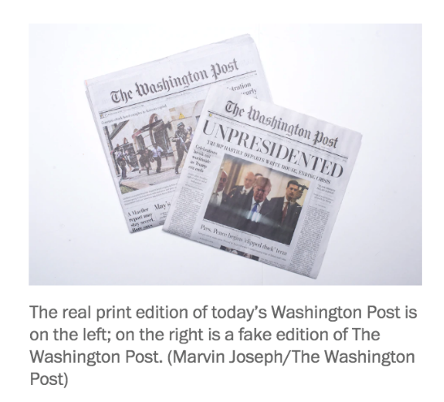Fabricated Content/Imposter Content
While satire and parody play on humorous attacks, this first level of “fake news” does not require immediate attention due to its widely acknowledged entertainment value. However, this next level of fake news, fabrication, requires a different response due to its lack of facticity and intent to deceive.
This type of information has no factual basis; however, the stories are presented or “published in the style of news articles to create legitimacy,” and often are believed to be a trustworthy source because partisan organizations often present information with some neutrality (Tandoc, Lim & Ling, 2018, p. 143).
According to the scholars, Tandoc, Lim and Ling (2018) research acknowledges that this type of information is often spread for the purpose of financial gain or now, more frequently, by artificial intelligence online sources.

On May 1, 2019, newspapers, appearing identical to The Washington Post, were distributed on the streets in Washington D.C. The headline, “Unpresidented,” appeared in large bold letters alongside a story which claims President Trump resigned from office. According to one of The Washington Post reports, the purpose of the newspaper was to show “the future and how we got there — like a road map for activists,” said Jacques Servin, a leader of the initiative (Heil & Farhi, 2019). The article also points out that the collection of fabricated materials cost nearly $40,000 to print and distribute which signifies the level of planned intention and commitment of spreading disinformation (Heil & Farhi, 2019).

In response to the distribution of look-alike newspapers, The Washington Post took immediate action by issuing a disclaimer warning that the paper was not legitimate on their Twitter account, “Washington Post PR.”
This was an important effort by public relations professionals because they shined light on the spread of disinformation as quickly as possible before releasing an official response. Later on, a spokeswoman Kris Coratti, responded by writing, “We will not tolerate others misrepresenting themselves as The Washington Post, and we are deeply concerned about the confusion it causes among readers. We are seeking to halt further improper use of our trademarks” (Heil & Farhi, 2019). While communication professionals may not have the ability to stop fake news stories from happening, implementing an instant response, by utilizing social media, can quickly stop false information, as fast as it is being shared.
Next Page: Fabricated Content/Imposter Content (continued)